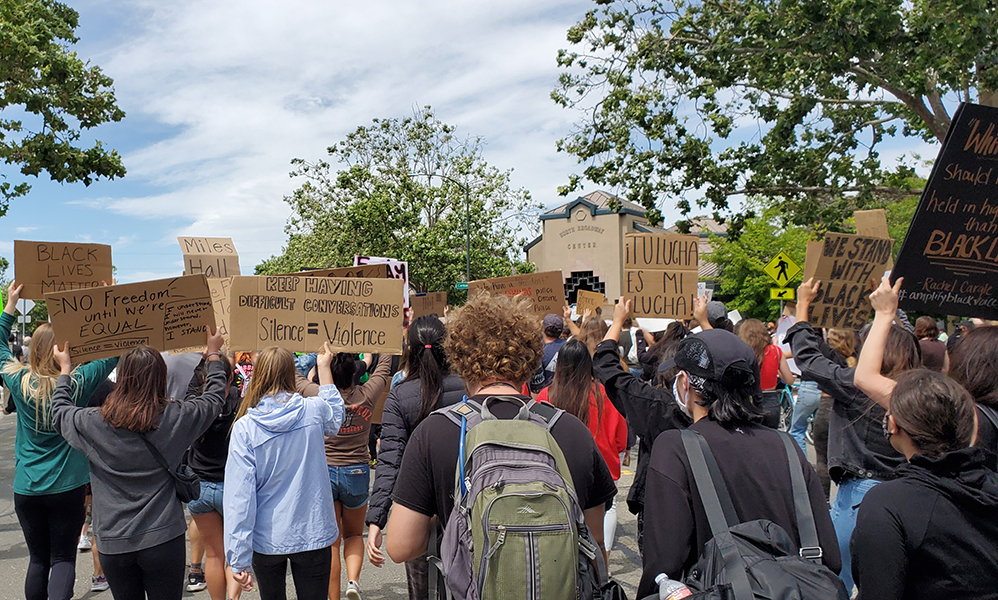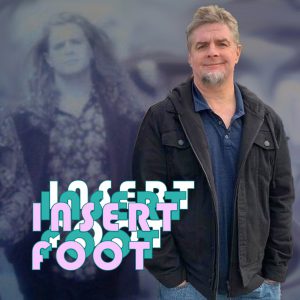Insert Foot: When social unrest comes to the suburbs, does anything really change?

Black Lives Matter protestors begin their march from Civic Park in Walnut Creek on June 5, 2020. Roman Gokhman/STAFF.
If you want to understand the relationship between police and those who they arrest, simply get yourself arrested some time.

Rendering: Adam Pardee/STAFF.
Even a peaceful, white suburban male not breaking the law—and who wasn’t charged (either time)—should try it. It’s enlightening. It also gives one better standing when throwing around opinions, which is all the rage. In some cases, literally … and with great cause.
That’s about all I have to share about that, other than saying the context has been useful while watching the nationwide turmoil over the George Floyd homicide. As is my time in central Contra Costa County, where I’ve lived and worked most of my life.
I’ve also worked as a reporter in bigger cities closer to the Bay, giving me a front-row seat to how crime is treated on either side of the Caldecott Tunnel.
This is a music magazine and, by extension, a pop culture publication. And America’s love (acceptance?) of minorities hasn’t come close to approaching its love of minority culture. Especially in music. The topic is relevant right town in just about any context.
I’ve also written about various communities, crime, education … whatever I could, for a few Bay Area newspapers. In doing so, I got a serious lesson in how differently things are perceived by just moving a few miles away.
What’s absolutely acceptable to those carrying power when it comes to one place (“That happens there; it’s what they do”) is met with near hysterical hand-wringing a 15-minute car ride away. “What’s happening to our poor little town? I don’t even recognize it anymore!”
Some of us do. Which could be a problem.
Walnut Creek, CA
Over the speaker
“IF YOU DO NOT MOVE YOU WILL BE DEAD.”IM SPEECHLESS
— Trump’sPissingMeOff SOS 🌊😘👠🦸♀️🌊 (@RetiredMaybe) June 3, 2020
An alleged crime that might’ve merited a small news brief on page seven in Richmond was front page news in Danville when I worked for papers rooted in either place. That wasn’t necessarily caused by the media, as much as it was expectations.
Someone shooting someone in Richmond was very different than someone shooting someone in Danville. All lives may indeed matter, but generally, some mattered more than others in that regard. Local news among higher-end, white-majority demographics liked the good news that comes with their status. When things occasionally went bad, it was a big deal. Headlines exploded. Never mind that those same kinds of stories happened frequently a few miles to the west. Local media reflected a community and its values. At least that was part of the premise.
So, seeing social media in the white suburbs go nuclear once some George Floyd civil unrest got loose in Walnut Creek was … cringeworthy. But not surprising.
There were plenty of people who genuinely care taking the suburban streets peacefully. This may not be the best time to painting large populations with giant brushstrokes.
To some, though, the issue finally mattered when windows were being broken in Nordstrom; even if as many looters were as white as they were black. Of course, looting is wrong. Of course, people were taking advantage—which can be an ironic term, but…
And, of course, people should be concerned when it comes to their town. But people are mad. People are lashing out. Whether that’s justified is another conversation. But judging by much of the social media reaction, it was clear many in the white suburbs don’t believe racism even exists, and fewer would do anything about it. The spread of chaos was seemingly blamed on out-of-towners, because the fine, upstanding people residing here would never behave in such ways. “How dare they bring their urban troubles here?”
14-year-old Isaiah Sandoval screams at police after being pushed off the freeway after being tear gassed. #walnutcreek #georgefloyd
It needs to be noted most of the protesters are young. pic.twitter.com/DiDkOXGM8R
— Denis Ivan Perez (@dpi_19) June 2, 2020
Then again, we sometimes only get what we see. When I was a kid in Walnut Creek in the mid-1970s, I saw a family down the street trying to sell their house for the longest time. They finally sold it to a black family, which was so shocking to our all-white neighborhood that the seller called all the neighbors—I’m assuming all, since my family didn’t know them, yet still got the call—and apologized for introducing a new race to the neighborhood.
This was only 40 years ago.
The new occupants were very nice people (as if they had a choice). But I remember the talk. N-bombs were frequently dropped. People speculated about their religion, which some believed was backward. They were treated like they weren’t as bright as everyone else.
It was an attitude I had hoped evolved since then. Then I saw the recent scattered shock and sadness of people believing their town suddenly lost its innocence. Suddenly, things weren’t fair … to them. I must’ve seen 50 posts on various social media outlets, lamenting how awful it is that things have changed, because poor Walnut Creek just didn’t used to be like this. This town used to be better than this.
Uh …
Second #BlackLivesMatter protest march in #WalnutCreek, a few minutes ago. pic.twitter.com/qqA9KO08qY
— Will Faught (@willfought) June 5, 2020
Follow music critic Tony Hicks at Twitter.com/TonyBaloney1967 .
